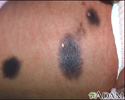Giant congenital nevus
Congenital giant pigmented nevus; Giant hairy nevus; Giant pigmented nevus; Bathing trunk nevus; Congenital melanocytic nevus - largeA congenital pigmented or melanocytic nevus is a dark-colored, often hairy, patch of skin. It is present at birth or appears in the first year of life.
A giant congenital nevus is smaller in infants and children, but it usually continues to grow as the child grows. A giant pigmented nevus is larger than 15 inches (in) or 38.1 centimeters (cm) once it stops growing.
Causes
These marks are thought to be caused by a localized increase in melanocytes as a baby grows in the womb. Melanocytes are the skin cells that produce melanin, which gives skin its color. A nevus has an increased amount of melanocytes.
The condition is thought to be caused by a variant gene.
The condition may occur with:
- Other nevi (moles)
- Involvement of the membranes of the brain and spinal cord when the nevus affects a very large area
Smaller congenital pigmented or melanocytic nevi are common in children and do not cause problems most of the time. Larger or giant nevi are rare.
Symptoms
A nevus will appear as a dark-colored patch with any of the following:
- Brown to bluish-black color
- Hair
- Regular or uneven borders
- Smaller affected areas near the larger nevus (sometimes)
- Smooth, irregular, or wart-like skin surface
Nevi are commonly found on the upper or lower parts of the back or the abdomen. They may also be found on the:
- Arms
- Legs
- Mucus membranes
- Palms or soles
Exams and Tests
You should have all birthmarks looked at by your health care provider. A skin biopsy may be needed to confirm the diagnosis or check for cancer cells.
Skin biopsy
A skin lesion biopsy is when a small amount of skin is removed so it can be examined under a microscope. The skin is tested to look for skin conditi...

An MRI of the brain or spine might be done if the nevus is over the spine. A giant nevus on the spine may be linked to brain or spinal cord problems.
MRI of the brain or spine
A head MRI (magnetic resonance imaging) is an imaging test that uses powerful magnets and radio waves to create pictures of the brain and surrounding...

Your provider will measure the dark skin area every year and may take pictures to check if the spot is getting larger.
Treatment
You will need to have regular exams to check for skin cancer.
Surgery to remove the nevus can be done for cosmetic reasons or if your provider thinks it may become skin cancer. Skin grafting is also done when needed. Larger nevi may need to be removed in several stages.
Skin grafting
A skin graft is a patch of skin that is removed by surgery from one area of the body and transplanted, or attached, to another area.

Lasers and dermabrasion (rubbing them off) can also be used to improve appearance. These treatments may not remove the whole birthmark, so it may be harder to detect skin cancer (melanoma). Talk to your provider about the pros and cons of surgery for you.
Dermabrasion
Dermabrasion is the removal of the top layers of the skin. It is a type of skin-smoothing surgery.

Melanoma
Melanoma is the most dangerous type of skin cancer. It is also the rarest. It is the leading cause of death from skin disease. Other common types o...

Treatment may be helpful if the birthmark causes emotional problems because of how it looks.
Outlook (Prognosis)
Skin cancer may develop in some people with large or giant nevi. The cancer risk is higher for nevi that are larger in size. However, it isn't known if removing the nevus reduces that risk.
Possible Complications
Having a giant nevus may lead to:
-
Depression and other emotional problems if the nevi affect appearance
Depression
Depression may be described as feeling sad, blue, unhappy, miserable, or down in the dumps. Most of us feel this way at one time or another for shor...
 ImageRead Article Now Book Mark Article
ImageRead Article Now Book Mark Article - Skin cancer (melanoma)
When to Contact a Medical Professional
This condition is usually diagnosed at birth. Talk to your child's provider if your child has a large, pigmented area anywhere on their skin.
References
Dinulos JGH. Nevi and malignant melanoma. In: Dinulos JGH, ed. Habif's Clinical Dermatology. 7th ed. Philadelphia, PA: Elsevier; 2021:chap 22.
Patterson JW. Lentigines, nevi, and melanomas. In: Patterson JW, ed. Weedon's Skin Pathology. 5th ed. Philadelphia, PA: Elsevier; 2021:chap 33.
-
Congenital nevus on the abdomen - illustration
Congenital nevi are present at birth and may range in size from less than one centimeter to the giant bathing trunk nevus, which covers a large area of the body. Skin texture may range from normal to raised, nodular to irregular, and they are frequently darkly pigmented. Melanomas may develop more easily in congenital nevi.
Congenital nevus on the abdomen
illustration
-
Congenital nevus on the abdomen - illustration
Congenital nevi are present at birth and may range in size from less than one centimeter to the giant bathing trunk nevus, which covers a large area of the body. Skin texture may range from normal to raised, nodular to irregular, and they are frequently darkly pigmented. Melanomas may develop more easily in congenital nevi.
Congenital nevus on the abdomen
illustration
Review Date: 10/14/2024
Reviewed By: Elika Hoss, MD, Assistant Professor of Dermatology, Mayo Clinic, Scottsdale, AZ. Also reviewed by David C. Dugdale, MD, Medical Director, Brenda Conaway, Editorial Director, and the A.D.A.M. Editorial team.



